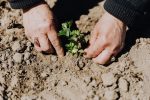How to properly take care of your garden according to the experts
Growing a garden can be an incredibly rewarding and fulfilling activity, but it also requires quite a bit of work. When you’re working so hard to cultivate your prized plants, pests will inevitably try to take over and destroy them. To ensure the health of your garden, you need to know how to properly care for it in order to identify and neutralise any threats.
If you fancy growing your own veg but are short on space or don’t have a garden – there are ways around this! Places like Silly Greens offer a grow-your-own vegetable and herb subscription service where you receive a weekly box to grow three microgreens. It’s super easy to do and you can easily have a windowsill herb garden of your very own!
A successful garden is a work of art. And like any work of art, it requires proper care and maintenance in order to thrive. But what does this mean for your yard? How can you ensure that all your hard work produces the best possible results?

What does a garden need?
A garden needs three things to grow: seeds, water, and sunlight. If you want your garden to grow, you need to provide these three things for it. The first thing a garden needs is seeds. Seeds are the foundation of any garden. Without seeds, all you have is dirt. You can’t grow a garden with just dirt, however.
The second thing a garden needs is sunlight. The third thing a garden needs is water. All gardens need these three things to flourish. If you don’t provide the right number of seeds, water, or sunlight, the plant won’t grow.
On the other hand, there are many other factors that will affect the health of your garden.
Soil acidity and pH levels play a big role in determining what plants will do best in your area. Most plants prefer soil with a neutral pH level, but you may need to amend the soil to suit certain plants. There are also multiple types of soil, which have different properties and nutrients. Picking the right one is key for growing healthy plants.
There are also many types of pests and diseases that can affect your garden. If you’re serious about making your garden as perfect as possible, you’ll have to learn more about lawn care and certain gardening techniques like hydroponics and indoor growing. As the team behind www.urbanorganicyield.com/ noted, there are online resources that cover all of that and more where you can learn about gardening techniques. Also, you can find a lot of info about different types of plants, growing veggies and so much more.
How much should you water your plants?
There is no hard and fast rule to this. It can vary depending on the weather, the location of your plants, their size, and the soil they are growing in. But the general rule is to water plants when the top layer of soil feels dry.
To check if the soil is dry or not, you can use your finger or a stick to dig into it. If it’s dry, pour some water into it and allow it to seep into the soil.
How to water plants: the right way:
The first thing you need to do is determine the type of plant you have. Some plants are better suited for watering than others. For example, if you have a cactus, don’t water it too much.
If you have a plant that is suited for watering, then follow these steps:
- First, determine how much water your plant needs. This will depend on the type of plant you have and how big it is.
- Then, water your plants when they need it. You can tell if a plant needs watering by looking at the soil around the plant. If the soil is dry, then it needs watering.
- After you water your plant, wait a few minutes and then check the soil again. If it’s still dry, then water it again.
What kind of tools do you need?
Maintaining a garden is not just about planting the seeds and watering them. It requires you to use the right tools for the job. There are different tools that are used for different jobs in the garden. A shovel is used to spread seeds, dig holes and remove weeds. A rake is used for levelling the ground and removing debris after weeding. A trowel is used for cultivating and transplanting plants.
A shovel, rake, pitchfork, hoe, trowel, or any other gardening tool will be useless without the proper maintenance. A good way to start caring for your gardening tools would be to clean them after every use, but be ready that after some time of usage, you will have to replace them. If you are using a tool for the first time, you should read the instructions on how to use it.
The tools that are used in gardening are usually made of metal or wood. They will need to be oiled or greased to prevent rusting. You can also apply a coating of paint to the wooden handles. The gardening tools that are used for digging should be sharpened regularly. A dull tool will only damage the soil and make it hard to work with.

Whether you are a true gardening enthusiast or just love the look of your garden in its best shape, there are several things you can do to keep your garden looking great. One of the best ways to ensure your garden is growing properly and efficiently is by following some simple guidelines.
![[AD] We went to the newly opened Cha Sha Kingston a couple of weeks ago, and wow — taste bud adventure unlocked! The boys devoured the masala fries and chicken tikka rolls, while we couldn’t get enough of that epic kebab butter curry 😍🍛.
It’s amazing value for food this tasty (and everyone left happy and VERY full!).
Delicious food, vibrant vibes and incredible value — the perfect combo for your next meal.
📍Cha Sha Kingston
43 Surbiton Road, KT1 2HG
🌐 chasha.co.uk
Other Cha Sha locations in Birmingham, Ilford, Southampton and Wembkey
#ChaSha #ChaShaKingston #KingstonEats #FoodieFinds #UKFoodie #FoodReview #KingstonUponThames #FamilyEats #FamilyDining #FoodieKids](https://suburban-mum.com/wp-content/uploads/2016/02/574770541_18560351146016840_6855048070839528040_n-180x320.jpg)

![[AD] We’re a cricket-mad family, so we’re buzzing that @thehundred is back this August! 🏏🔥
To get ready, M tried out the official FREE Activity Pack — and it’s brilliant! 🙌
Packed with fun games, creative challenges and sporty tasks, it’s perfect for getting kids hyped whether you’re at home or on the go.
👉Download yours now (link in bio)
@londonspirit @ovalinvincibles #EveryMomentCounts #TheHundred
#EnglandCricket #CricketFamily #TheHundredCricket #LondonBloggers #Cricket #CricketIsLife #kidsfun](https://suburban-mum.com/wp-content/uploads/2022/11/505472555_18531279601016840_7092520074819907569_n-180x320.jpg)



![[AD - Press visit]
We enjoyed the glorious sunshine this weekend with a trip to Brighton. We went on the @brightoni360official which is right by the sea front.
The i360 pod take a slow journey up, allowing you to take in views across Brighton and the South Downs 450ft above ground. There’s a bar inside with drinks and snacks available to purchase and the experience lasts 25 minutes.
Afterwards, we headed to the open air roller rink for a roller skating session!
The roller rink is:
⭐ Suitable for over 5s
⭐ £6.50 if you have your own skates or £9.50 if you need to hire them
⭐ 45 minutes per session
Full details to visit the i360 + skating
📍 Brighton i360, Lower Kings Road, Brighton BN1 2LN
🚗 Parking nearby (we parked in the Regency Square Car park)
🎟️ Prices start from £25.40 for an adult and £16.90 for a child
🕐 Opening hours are currently Sun-Fri 10.30am-18.30pm and until 19.30pm on Saturdays
☕️ Bar inside the i360, cafe and gift shop
Book tickets here:
https://tickets.brightoni360.co.uk/tickets/?_ga=2.195305772.1869001490.1689671753-1757164059.1689671753/#events?eventid=157](https://suburban-mum.com/wp-content/uploads/2015/04/417980235_313576471048632_3682382982231216432_n.jpg)

![[AD] ***Summer of fun at Barracudas Activity Camps!****
There is plenty for kids to do at @barracudas_activity_day_camps
From Tennis, Archery, Swimming, Motor Sports and more you can be sure that there will be something for kids aged 4.5-14. ⚽🏈🥅🎾🏓🏎️🏹🏊♂️🏉
You can book on a day by day basis - so it can fit in with any other days out/activities you have planned and there are early drop off and late pickup options available. Barracudas are also Ofsted registered so you can use your Childcare Vouchers too.
⭐⭐⭐Get £20 off a week or £4 off a day using my discount code: MARIA20⭐⭐⭐
#BarracudasActivityDayCamp #BarracudasActivityCamp #BarracudaAmbassadors #SummerHolidays #SchoolHolidays #Summer2023 #SummerCamp #DayCare #Camp #KidsCamp #surreymummy #surreymums #SummerOfFun #ActivityCamps #HolidayCamps #Childcare #SchoolHolidays #schoolholidaycamps](https://suburban-mum.com/wp-content/uploads/2024/07/353583570_625625966167953_545896259645102575_n.jpg)



![[AD] We have some super exciting news...we have been chosen to be Laser Quest Ambassadors, and the boys are over the moon!
We are really lucky that our local Laser Quest (@laserquestkingston) is just around the corner from us. It means we can pop in of a weekend or anytime during the school holidays, and with summer just around the corner, I know Laser Quest will be one of our go-to places for some family fun.
As well as games of Laser Quest, there are also VR experiences and arcade amusements too. To find out a bit more about how Laser Quest works, you can read my blog post: https://www.suburban-mum.com/laser-quest-kingston/ (clickable link in bio)
Don't forget to keep an eye out for our Laser Quest posts - I'm going to be giving away two family passes to use at Laserquest Kingston!
If you can't wait and want to head down to Laser Quest to try it out, use the code SUMMER30 for 30% off your booking. The code is valid from now until the end of August 2023 and can be used on Laser Quest games and birthday party bookings.
#LaserquestAmbassador #Laserquest #LaserquestKingston #ActivitiesForKids #FamilyFun #DaysOutWithKids #Lasertag #LaserquestVR #Kingston #ThingsToDoInKingston #SurreyFamilyDaysOut #ThingsToDoWithKids #RainyDayFun #SurreyMummy #SurreyLife #LifeWithKids #LifeWithBoys #familyfunday](https://suburban-mum.com/wp-content/uploads/2015/04/353230107_797358078406942_2405522556733455165_n.jpg)

![[AD] The sun has finally made an appearance and the boys have been making the most of it by spending it
in the garden.
They’re go-to is always football and they’ve been trying to improve their aim and accuracy with the new Messi Foldable Footlball goal from the #MessiTrainingSystem range.
I love the fact the goal is foldable, making it easy to store away when not in use. It is also lightweight so you can effortlessly pack it up and take it to the park or to a friend’s house.
The Messi Foldable Football Goal retails at £36 and can be purchased from @argos
You can read my full review here: https://www.suburban-mum.com/messi-foldable-football-goal/
#TrainLikeMessi #FoldableFootballGoal #FootballSkills #OutdoorFun #LionelMessi #LeoMessi #FootballAtHome #OutdoorKids #JustGetOutside #OutdoorsAndFree #ScreenFreeKids #WhateverTheWeatherKids @flair_gp](https://suburban-mum.com/wp-content/uploads/2015/04/341194882_615024710178056_41977149395989448_n.jpg)

![[AD] We are absolutely thrilled to announce that we are Barracuda Ambassadors again this year.
With Easter just around the corner, the boys were sent the @barracudas_activity_day_camps new camp kit in preparation for the school holidays.
There’s a wide range of activities for kids aged 4.5 - 14 including Tennis, Archery, Basketball, Arts & Crafts and more.
If you like the sound of Barracudas, find out more over on their website. You can also save £20 a week or £4 a day, using my discount code: MARIA20](https://suburban-mum.com/wp-content/uploads/2024/07/336812306_765234558514317_685553691647241974_n.jpg)


![[AD - Gifted]
Last weekend we were invited to try out @tsarettaspice’s new Bottomless Brunch menu and I can tell you it was thumbs up all round!
There’s a good choice tapas on offer from Punjabi fish fingers, Indo Chinese Chicken to Spiced Lamb Scotch Eggs and Manchurian Cauliflower (which was amazing!)
If you’re local to Twickenham and fancy giving them a try here’s are the details.
Tsaretta Spice Bottomless Brunch
⭐️£37.50 per head for bottomless Prosecco or cocktail of the day
⭐️£55 per head for bottomless Champagne
⭐️ Food included: 4 tapas selections and dessert or 2 tapas selections, a pav or naanwich and dessert
⭐️ Non-alcohol brunch is also available
Tsaretta Spice
55 Church Street
Twickenham
TW1 3NR
You can also read our full review over on the blog (link in bio)](https://suburban-mum.com/wp-content/uploads/2024/07/334565436_5960402314015030_663031098700829518_n.jpg)



